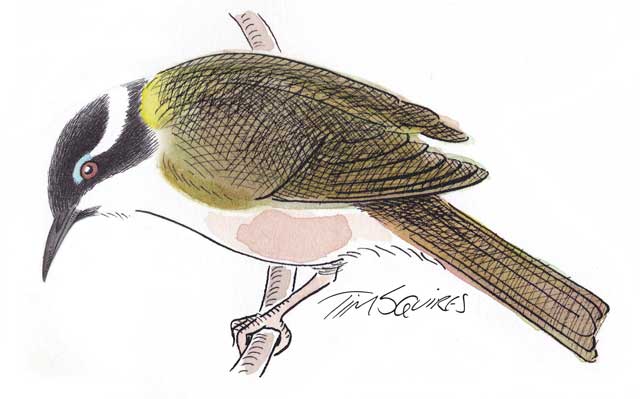
I looked a little out of place on the mountain – black street shoes, neatly-pressed grey trousers, light blue button-down shirt, no hat or drink bottle.
I had intended to go Christmas shopping but on my way to town I met a birdwatcher who said that the showy shrub, Christmas bush, was in bloom on Mt Wellington. The sun was shining after a day of rain and I couldn’t resist driving to the Springs to have a look at these tall, leafy shrubs that always flower towards the end of December. This year they were a little early …. and Christmas shopping would have to wait.
Flowering Christmas bushes are as big an attraction on the mountain as the red blooms of waratah but they eluded me at first. The tube-like, two-lipped flowers come in white and pale lilac and are spotted with purple. I couldn’t find them on a short walk at the Springs and the prospect of seeing them, and hearing the mountain birds, lured me higher and before long I was in a full-blown four-kilometre hike along the Pinnacle and then the Organ Pipes tracks.
Mt Wellington is like that. Seductive and beguiling, taking you to places you do not necessarily want to go.
An olive whistler was singing at the Springs at the start of my latest adventure and it seemed a good idea to go in search of not only the Christmas bush but a bird species that frequently hides from me on the mountain, the endemic strong-billed honeyeater.
The sightings of “strong-bills” had been so rare during the year that I had dusted down a CD of Tasmanian bird sounds and learnt the song once again.
As I made my way up the mountain, crescent honeyeaters were singing all about me, as they always do on the higher slopes where they migrate to breed in summer, and after a short time, climbing ever higher, I came across a whole family: parents and three fluffy juveniles, drinking in the cool waters of a spring.
At last I noticed a Christmas bush in flower. Not only this but the red blooms of waratahs and the tiny, white daisy-like ones of satinwood fought for sunlight under a canopy of snow peppermint gums. I was lured even higher by the beauty of it all, although the wind was now getting up and I struggled to move forward in exposed locations at the junction of the Organ Pipes and the Zig-Zag trails, the latter climbing to the summit. The wind whipped flower petals from the shrubs and now the way ahead of me was a carpet of red and white petals.
I had the trail to myself before another walker came into view, coming towards me in full hiking gear – stout boots, sensible shirt, waterproof trousers, and gaiters to ward off leeches. I hadn’t even thought of the menace of leeches.
The lone hiker said she had started out early to climb to the summit and the flowers along the Organ Pipes Trail had been the highlight of the day. When she described them I felt compelled to press on. I had after all reached the point of no return and it would be easier for me to hike to the end of the Organ Pipes Trail at the Chalet and return to the Springs on an easier route down thePinnacle Rd.
There was reward for my efforts beyond the rich floral landscape. Ahead of me a strong-billed honeyeater was busily prising off the bark of a wind-bent gum just at the treeline, in search of insects.
Tired and sunburnt, an hour after finding the strong-bill, I slowly made my way down to the Springs. A kindly motorist stopped. Had I broken down, he asked? Did I need help? I might have had binoculars strung around my neck, and a book on plants hanging out of my pocket, but my muddy town shoes and grey trousers suggested I was not a man for the mountains after all.